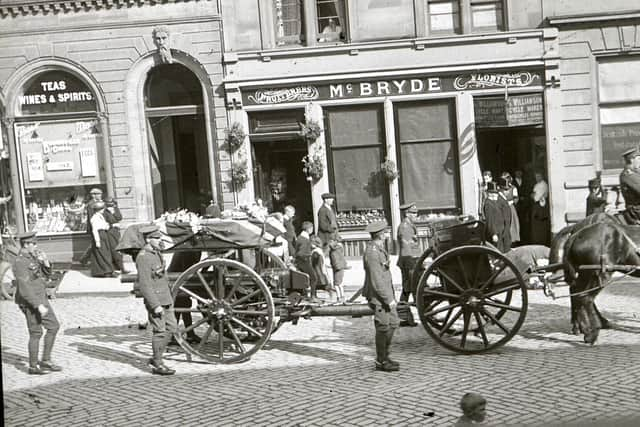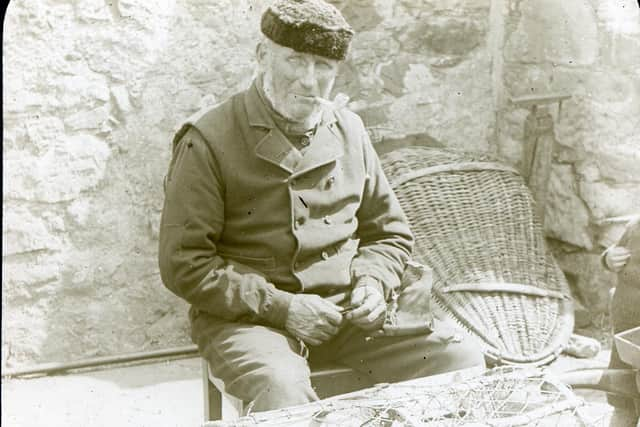Photographs of life in rural Scotland in 50 years before Second World War to be displayed in Fife
Images from the 1890s until the 1940s captured blizzards, the first military funeral of the First World War in Cupar, Fife, and even a circus elephant.
George Normand, who was born in Cupar, started taking pictures in the 1890s when he was covering 18 miles a day on foot in the surrounding area. The postman was aged 18 and did four rounds a day, starting at 6am and finishing at 9pm.
Advertisement
Hide AdAdvertisement
Hide AdHe photographed farm labourers, Crail fishermen and traders, as well as freak weather including a huge snowdrift.


During his rounds, Normand battled through blizzards in 1916, and waded through waist-deep, flood water to reach the Post Office at Pitscottie in 1917.
The water was within half an inch of the counter top, but despite the risks Normand captured these moments on film.
The photographs, taken over 50 years, will go on display at the Duncan Institute, in Cupar, which has recently been refurbished and is run by OnFife.
Andrea McMillan, OnFife's local studies supervisor, said: "George Normand's photographs offer us a rare glimpse into the lives of ordinary people over 50 years as they go about their daily business.


"As we look into the eyes of his subjects, we feel a deep connection to those who lived here more than 100 years ago."
Normand joined the Army in 1917 and served overseas in the Army Veterinary Corps for two years. Returning to Fife, he was promoted to the position of supervising postman in Cupar and remained in this job until retiring in 1935.
Normand went on to use a pony-and-trap to complete his rounds, before using a bicycle, and worked as a postman for 46 years. He died aged 102 on Christmas Day, 1976.
Advertisement
Hide AdAdvertisement
Hide AdThe absence of traffic in the rural idyll now seems striking, and castles and churches as well as shopping streets show how the area developed.
Landmark events such as the announcement at Cupar Cross of the Relief of Mafeking on May 17 1900, and Cupar's first military funeral of the 1914-18 war, were caught on film.
Portraits of workers and local dignitaries are on display, as well as informal moments in rural life such as skaters and curlers on frozen ponds, Sunday school children on summer picnics and farmhands seeking work at Cupar's biannual hiring fair.
Normand shared his images with local people using his Magic Lantern – bought for £22 15s in 1898 – to project his glass slides on to a linen screen. The slides have now been preserved as more than 200 digital images, making them accessible to anyone with an interest in history and photography.
Some photographs have an artistic quality, such as a Crail fisherman mending creels wearing a black hat and smoking a pipe, which evokes Vincent van Gogh's self portrait.
Another photo, Piece Time at Larennie Farm, which captures crops and white-capped farm girls, was compared to a Van Gogh landscape.
One photo, showing a circus elephant and rider on Cupar's Crossgate, captures a comic moment, with another showing a bizarrely shaped egg and a turnip growing through a pair of scissors.
Along with provosts and reverends, two local dignitaries were photographed: Jimmy Dickie and "General" Gordon – popping up time and again, sometimes with refreshments in hand, larking about with carefree abandon.
Advertisement
Hide AdAdvertisement
Hide AdThe images will be displayed by OnFife, which runs the Duncan Institute, and will be exhibited at a local studies open day on January 18.
Private viewings can also be arranged.
Dr Tom Normand (no relation), of the School of Art History at the University of St Andrews, said: "That acute sense of the local, and of celebrating the everyday, is surely a triumph of photography.
"George Normand seems to have recognised this and become something of a champion of the art."
Comments
Want to join the conversation? Please or to comment on this article.